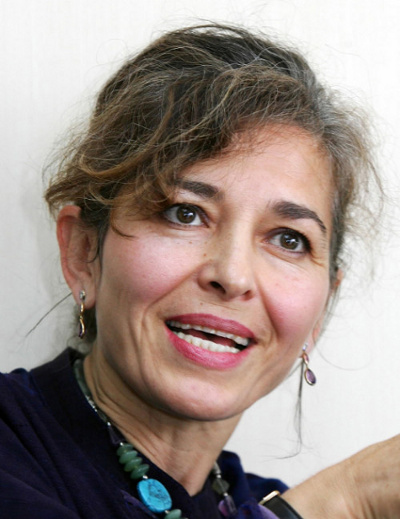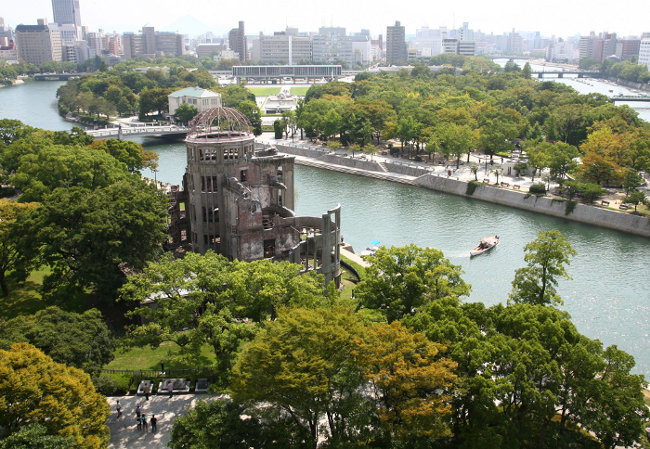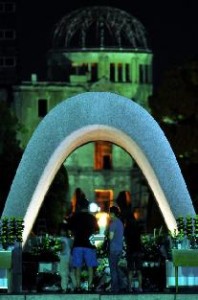Hiroshima and the World: Meditations from Hiroshima Peace Memorial Park
Mar. 23, 2009
by Nassrine Azimi
Nassrine Azimi
Ms. Azimi was born in Iran in 1959 and educated in Switzerland. She has served as director of the United Nations Institute for Training and Research in Hiroshima (UNITAR) since 2003, the year she helped establish this UNITAR branch. Prior to this, she was coordinator of UNITAR’s environmental training programs in Geneva. Since 1994 she has directed a publication series on Peacekeeping, for which she has edited or co-edited seven books. She has also written and published extensively on post-conflict reconstruction and environmental stewardship of the seas. Ms. Azimi has a post-graduate degree in urban studies from the School of Architecture of the University of Geneva and an MA in international relations from the Graduate Institute of International Studies in Geneva.
Spring is fast approaching in Hiroshima. From my office windows I can see the full expanse of Hiroshima Peace Memorial Park, designed in 1948 by Kenzo Tange. The young Tange was an admirer of modernist architect Le Corbusier, and his elegant design captures both his youthful, futuristic aspirations and his Japanese sensitivities. In the center of the Park and sitting in a reflecting pool is the arc-shaped Cenotaph, containing names of the Bomb’s victims. A peace flame, said to be brought from nearby Miyajima Island, burns behind. To the north is the rebuilt T-Bridge, the original target of the Enola Gay that sweltering Monday morning in August 1945. And on the edge of the Park is the Atomic Bomb Dome, a UNESCO World Heritage Site and one of the rare structures left standing after the explosion. Today the Dome, with its crooked spikes, is an iconic anti-nuclear and peace symbol, a silent but persistent reminder of the kind of hell that looms behind the smooth jargon of nuclear debates.
I have lived in this city more than five years but still do not cease to be amazed by the spirit that animates Peace Park. As a student of architecture, I admire the continued vitality of its elegant design; as a citizen of the world, I am moved, like so many before me, by the human stories it has to tell. Every morning fresh flowers are deposited at the Cenotaph. Elsewhere volunteers sweep the grounds and lovingly tend to the memorial stones honouring the dead. There are commemorative plates, too, for those who extended a helping hand at the time of Hiroshima’s greatest need. I frequently visit the monument dedicated to Marcel Junod, the remarkable Swiss doctor and head of the International Committee of the Red Cross in Japan, who first brought desperately-needed medical supplies to the bloodied city after the catastrophe. It should be a civic duty to visit, at least once in every lifetime, Hiroshima or Nagasaki. For our leaders, it should be made mandatory.
My organization, UNITAR, is the first and only UN presence in Hiroshima. I have been to many UN capitals, but rarely am I more moved by the UN flag than here, seeing it afloat close to Peace Park. And the hundreds of experts from Asia and around the world who attend our programmes here seem to share the sentiment. My colleagues and I make the visit of Peace Memorial Museum and Peace Park part of every event--and there are few who go through the experience without emerging a little transformed, more grave and circumspect maybe in their opinions about nuclear weapons.
Hiroshima and Nagasaki may at times give the wrong message to their visitors: both are green and thriving cities, with lively pedestrian areas and, in appearance at least, tackling problems like those of any ordinary city. Frequently this can lull outsiders into a false sense of security--that maybe it is possible to rebound from nuclear warfare. But reality dictates otherwise: the capacities of Little Boy and Fat Man, as the two bombs were incongruously named in 1945 by their handlers, were insignificant compared to the destructive powers of today’s nuclear technology. Even so, the Hiroshima Bomb created a furnace of such heat and pressure that it turned everything in a two-kilometre radius--flesh, building, and nature--into ash, killing 140,000 people on the spot or within a few months of the blast. The dead died atrociously and the living lived to regret not having died.
Hiroshima’s three guiding principles--to forgive but not to forget; never again (to nuclear war); and transformation from a military city to a city of peace--should echo in every post-conflict country striving to rebuild. Hiroshima opted for life and those who have seen its many trees--palm, pine, cherry, ginko, camphor, oak--some 6,000 were planted within two years after the Bomb--surely sense this. Peace Park therefore embodies, in the monuments, twisted trunks and sober structures that dot it, Hiroshima’s two compelling messages--destruction and resurrection. This double narrative, tangible and intangible values intertwined, is its most important legacy, reminding us that it is both the concrete forms and the philosophical underpinnings of Hiroshima that make it such a powerful place--and that carry deep significance today--as much in Afghanistan as for Ground Zero in New York.
There are those who continue to believe that the atomic bombings of Hiroshima and Nagasaki ended World War II in Japan. We must tackle this myth head-on, for its pervasive presence hinders efforts to put to rest the nuclear race death-wish. The myth started, as Robert Lifton masterfully describes in his Hiroshima in America in the United States shortly after the war. It was used by the Japanese imperial army, for self-serving reasons of its own. Beyond these calculated and contrived interpretations, however, even a sincere belief in the inevitability of the nuclear bombings are, from the perspective of Hiroshima, secondary. Here the overriding sentiment is the desire to never again see the human race take the path of nuclear war--or do so at its own peril. Robert Oppenheimer, father of the Manhattan Project, was prescient of the monster he was unleashing when he wrote in his memoirs that on observing the atomic testing in the deserts of New Mexico in July 1945, he thought of lines from the Hindu scripture, the Bhagavad-Gita: “I am become Death, the destroyer of worlds.” The Pandora’s Box of nuclear annihilation was opened in Hiroshima; it will require our collective will and ingenuity to put it back in. The citizens of Hiroshima, having contemplated in their hearts both the senseless ideology that led them to war and the merciless bomb that unleashed upon them the fury of the Armageddon are our guides, in this voyage of transformation and redemption.
Beneath the green and gentle veneer of my adopted city therefore is a bruise, a memory so painful that much like other human tragedies it simply cannot be described in words. But Hiroshima chose to live and anyone who visits its Peace Park for the first time also understands the courage and resilience it must have taken its citizens to return, rebuild their city and dedicate it to the abolition of nuclear weapons.
The A-bomb Dome is rightfully, alongside Auschwitz, one of the most important heritage of humanity. I hope to see more and more people, from all walks of life, visit it and the rest of Peace Park--not only peace activists but also lawyers, doctors, businessmen, academics, priests and mullahs, military and security officials. Like the scientists, port authorities, marine biologists, museum curators, architects, archeologists and world heritage site managers participating in UNITAR programmes--these visitors will be changed by the experience that is Hiroshima and, in turn, return home to change the places to which they carry Hiroshima’s message, cautioning and inspiring at the same time.
In my early morning walks in Peace Park these days, I have come to admire the new additions to the reflecting pool--eight stone plates carved in different languages, reminding us again both of Hiroshima’s “prayers for peace” and of our own common humanity.
To comment on this article, please click the link below. Comments will be moderated and posted in a timely fashion. Comments may also appear in the Chugoku Shimbun newspaper.
Nassrine Azimi
Ms. Azimi was born in Iran in 1959 and educated in Switzerland. She has served as director of the United Nations Institute for Training and Research in Hiroshima (UNITAR) since 2003, the year she helped establish this UNITAR branch. Prior to this, she was coordinator of UNITAR’s environmental training programs in Geneva. Since 1994 she has directed a publication series on Peacekeeping, for which she has edited or co-edited seven books. She has also written and published extensively on post-conflict reconstruction and environmental stewardship of the seas. Ms. Azimi has a post-graduate degree in urban studies from the School of Architecture of the University of Geneva and an MA in international relations from the Graduate Institute of International Studies in Geneva.
Meditations from Hiroshima Peace Memorial Park
Spring is fast approaching in Hiroshima. From my office windows I can see the full expanse of Hiroshima Peace Memorial Park, designed in 1948 by Kenzo Tange. The young Tange was an admirer of modernist architect Le Corbusier, and his elegant design captures both his youthful, futuristic aspirations and his Japanese sensitivities. In the center of the Park and sitting in a reflecting pool is the arc-shaped Cenotaph, containing names of the Bomb’s victims. A peace flame, said to be brought from nearby Miyajima Island, burns behind. To the north is the rebuilt T-Bridge, the original target of the Enola Gay that sweltering Monday morning in August 1945. And on the edge of the Park is the Atomic Bomb Dome, a UNESCO World Heritage Site and one of the rare structures left standing after the explosion. Today the Dome, with its crooked spikes, is an iconic anti-nuclear and peace symbol, a silent but persistent reminder of the kind of hell that looms behind the smooth jargon of nuclear debates.
I have lived in this city more than five years but still do not cease to be amazed by the spirit that animates Peace Park. As a student of architecture, I admire the continued vitality of its elegant design; as a citizen of the world, I am moved, like so many before me, by the human stories it has to tell. Every morning fresh flowers are deposited at the Cenotaph. Elsewhere volunteers sweep the grounds and lovingly tend to the memorial stones honouring the dead. There are commemorative plates, too, for those who extended a helping hand at the time of Hiroshima’s greatest need. I frequently visit the monument dedicated to Marcel Junod, the remarkable Swiss doctor and head of the International Committee of the Red Cross in Japan, who first brought desperately-needed medical supplies to the bloodied city after the catastrophe. It should be a civic duty to visit, at least once in every lifetime, Hiroshima or Nagasaki. For our leaders, it should be made mandatory.
My organization, UNITAR, is the first and only UN presence in Hiroshima. I have been to many UN capitals, but rarely am I more moved by the UN flag than here, seeing it afloat close to Peace Park. And the hundreds of experts from Asia and around the world who attend our programmes here seem to share the sentiment. My colleagues and I make the visit of Peace Memorial Museum and Peace Park part of every event--and there are few who go through the experience without emerging a little transformed, more grave and circumspect maybe in their opinions about nuclear weapons.
Hiroshima and Nagasaki may at times give the wrong message to their visitors: both are green and thriving cities, with lively pedestrian areas and, in appearance at least, tackling problems like those of any ordinary city. Frequently this can lull outsiders into a false sense of security--that maybe it is possible to rebound from nuclear warfare. But reality dictates otherwise: the capacities of Little Boy and Fat Man, as the two bombs were incongruously named in 1945 by their handlers, were insignificant compared to the destructive powers of today’s nuclear technology. Even so, the Hiroshima Bomb created a furnace of such heat and pressure that it turned everything in a two-kilometre radius--flesh, building, and nature--into ash, killing 140,000 people on the spot or within a few months of the blast. The dead died atrociously and the living lived to regret not having died.
Hiroshima’s three guiding principles--to forgive but not to forget; never again (to nuclear war); and transformation from a military city to a city of peace--should echo in every post-conflict country striving to rebuild. Hiroshima opted for life and those who have seen its many trees--palm, pine, cherry, ginko, camphor, oak--some 6,000 were planted within two years after the Bomb--surely sense this. Peace Park therefore embodies, in the monuments, twisted trunks and sober structures that dot it, Hiroshima’s two compelling messages--destruction and resurrection. This double narrative, tangible and intangible values intertwined, is its most important legacy, reminding us that it is both the concrete forms and the philosophical underpinnings of Hiroshima that make it such a powerful place--and that carry deep significance today--as much in Afghanistan as for Ground Zero in New York.
There are those who continue to believe that the atomic bombings of Hiroshima and Nagasaki ended World War II in Japan. We must tackle this myth head-on, for its pervasive presence hinders efforts to put to rest the nuclear race death-wish. The myth started, as Robert Lifton masterfully describes in his Hiroshima in America in the United States shortly after the war. It was used by the Japanese imperial army, for self-serving reasons of its own. Beyond these calculated and contrived interpretations, however, even a sincere belief in the inevitability of the nuclear bombings are, from the perspective of Hiroshima, secondary. Here the overriding sentiment is the desire to never again see the human race take the path of nuclear war--or do so at its own peril. Robert Oppenheimer, father of the Manhattan Project, was prescient of the monster he was unleashing when he wrote in his memoirs that on observing the atomic testing in the deserts of New Mexico in July 1945, he thought of lines from the Hindu scripture, the Bhagavad-Gita: “I am become Death, the destroyer of worlds.” The Pandora’s Box of nuclear annihilation was opened in Hiroshima; it will require our collective will and ingenuity to put it back in. The citizens of Hiroshima, having contemplated in their hearts both the senseless ideology that led them to war and the merciless bomb that unleashed upon them the fury of the Armageddon are our guides, in this voyage of transformation and redemption.
Beneath the green and gentle veneer of my adopted city therefore is a bruise, a memory so painful that much like other human tragedies it simply cannot be described in words. But Hiroshima chose to live and anyone who visits its Peace Park for the first time also understands the courage and resilience it must have taken its citizens to return, rebuild their city and dedicate it to the abolition of nuclear weapons.
The A-bomb Dome is rightfully, alongside Auschwitz, one of the most important heritage of humanity. I hope to see more and more people, from all walks of life, visit it and the rest of Peace Park--not only peace activists but also lawyers, doctors, businessmen, academics, priests and mullahs, military and security officials. Like the scientists, port authorities, marine biologists, museum curators, architects, archeologists and world heritage site managers participating in UNITAR programmes--these visitors will be changed by the experience that is Hiroshima and, in turn, return home to change the places to which they carry Hiroshima’s message, cautioning and inspiring at the same time.
In my early morning walks in Peace Park these days, I have come to admire the new additions to the reflecting pool--eight stone plates carved in different languages, reminding us again both of Hiroshima’s “prayers for peace” and of our own common humanity.
To comment on this article, please click the link below. Comments will be moderated and posted in a timely fashion. Comments may also appear in the Chugoku Shimbun newspaper.










